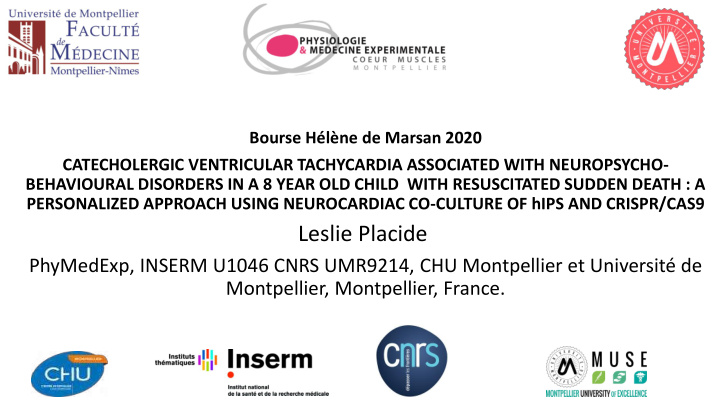



Bourse Hélène de Marsan 2020 CATECHOLERGIC VENTRICULAR TACHYCARDIA ASSOCIATED WITH NEUROPSYCHO- BEHAVIOURAL DISORDERS IN A 8 YEAR OLD CHILD WITH RESUSCITATED SUDDEN DEATH : A PERSONALIZED APPROACH USING NEUROCARDIAC CO-CULTURE OF hIPS AND CRISPR/CAS9 Leslie Placide PhyMedExp, INSERM U1046 CNRS UMR9214, CHU Montpellier et Université de Montpellier, Montpellier, France.
INTRODUCTION Catecholergic polymorphic ventricular tachycardias (CPVT) may be associated to epilepsy or neuropsycho-behavioural disorders suggesting a common cardiac and neuronal dysfunction. This project proposes to elucidate the molecular mechanisms of this association using the human induced pluripotent stem cells tool (IPSC) and genetic correction by CRISPR/CAS9. We will model the CPVT syndrome and neuronal dysfunctions using IPSC from 1 patient with CPVT and autistic disorders from a cohort of 71 patients with RyR2 mutations. We will study the molecular and functional properties of healthy and diseased IPSC-CMS and IPSC-NRS and evaluate via a personalized pharmacological analysis the impact of treatments on IPSC-NRS/IPSC-CMS co-cultures in microfluidic devices. We hypothesize that cardiac arrhythmias are not only the result of a malfunction of cardiomyocytes but also of a neuronal defect upstream of these cardiomyocytes. In this context, we propose to model the rare neurocardiac pathology associated with a point mutation from "patient-specific" cardiomyocytes and neurons from hiPSC. We also hypothesize that neurocardiac co-culture via microfluidic chips constitutes an innovative human cellular model for studying, at the molecular and functional level, neuron- cardiomyocyte interactions in a physiological context and in the context of hereditary neurocardiac pathology. The results will lead to a better understanding and management of the neurocardiac disorders in a context of personalized medicine.
PERSONALIZED APPROACH USING NEUROCARDIAC CO- CULTURE OF hIPS AND CRISPR/CAS9
Modélis lisatio ion du syndrome CP CPVT par cocult lture neuro-cardia iaque via via des s puces micr icrofl fluid idiq iques et l’outil iP iPSC SC « patie ient-specif ific ic » • We propose to model the CPVT syndrome by generating hiPSC-derived cardiomyocytes (hiPSC-CMs) and co- culturing them with hiPSC-derived neurons (hiPSC-NRs). • The Helene de Marsan funding requested in this research project will fund reprogramming and differenciation of the hIPSCs of this patient. • Objective 1: Reprogram the hiPSCs of this patient using CRISPR/Cas9 technology to generate isogenic control. A healthy control subject hiPSC line available at PhyMedExp will also be used as a non-isogenic control. • Objective 2: Differentiate mutant hiPSCs and controls into hiPSC-CMs. Differentiate hiPSCs into catecholaminergic hiPSC-NRs. A co-culture comparison between mutant hiPSC-CMs and controls co-cultured with hiPSC-NRs will be performed to estimate the neural impact on healthy and diseased hiPSC-CMs. • Objective 3: To study the molecular and functional properties of hiPSC-CMs and hiPSC-NRs • Objective 4: To perform a comparative and differential pharmacological analysis to evaluate the impact of treatments on cardiomyocytes and/or neurons on hiPSC-NRs / hiPSC-CMs co-cultures in microfluidic devices with beta-blockers (Nadolol), flecainide, Rycal (S107) or anticalcics based on clinical treatment and follow-up data.
L’équipe de recherche qui réalisera ce projet est constituée de : : • Jean-Luc Pasquié (PU-PH) : Cardiologue rythmologue. Recrutement, suivi clinique de la cohorte, décisions thérapeutiques et orientation pharmacologique. • Alain Lacampagne (DR1 CNRS) : expertise imagerie, électrophysiologie. • Albano Meli (CRCN Inserm) : Différenciation cardiaque et neuronale des hiPSC, imagerie et électrophysiologie. • Albin Bernardin (Doctorant) : Différenciation cardiaque et neuronale des hiPSC et co-culture dans les dispositifs de microfluidiques. • Valérie Scheuermann (AI Inserm) : Culture cellulaire et analyse moléculaire.
Recommend
More recommend